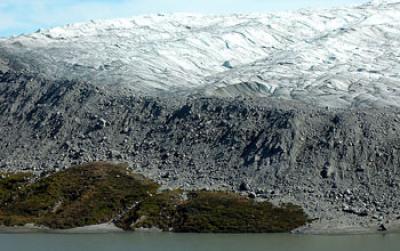A new study details changes in Earth's climate from more than 100,000 years ago and indicates that the last interglacial, the term for the periods between "ice ages", was warmer than previously thought.
The research findings also indicate that melting of the massive West Antarctic ice sheet may have contributed more to sea-level rise at that time than melting of the Greenland ice sheet.
The new results from the North Greenland Eemian Ice Drilling (NEEM) project, managed by Denmark's Centre for Ice and Climate, show that during the Eemian interglacial, the climate in North Greenland was about 8 degrees Celsius warmer than at present. The Eemian interglacial period began about 130,000 years ago and ended about 115,000 years ago.
The Greenland ice core layers, formed over millennia by compressed snow, are being studied in detail using a suite of measurements, including stable water isotope analysis that reveals information about temperature and moisture changes back in time. Lasers are used to measure the water stable isotopes and atmospheric gas bubbles trapped in the ice cores to better understand past variations in climate on a year-by-year basis, similar in some ways to a tree-ring record.
Despite this strong warming signal during the Eemian, a period when the seas were roughly four to eight meters higher than they are today, the surface in the vicinity of NEEM was only a few hundred meters lower than its present level, which indicates that the Greenland ice sheet may have contributed less than half of the total sea rise at the time.
The researchers looked at surface elevation and ice thickness in the early and later parts of the Eemian. Following the previous glacial period, 128,000 years before present, the surface elevation in the vicinity of NEEM was 200 meters higher than the present and the ice thickness decreased at a very high rate of 6 centimeters per year. Some 122,000 years before the present, the surface elevation was 130 meters below the present. In the late Eemian, 122,000 to 115,000 before present, the surface elevation remained stable at a level of 130 meters below the present with an ice thickness of 2,400 meters.
The research team estimated the Greenland ice sheet's volume reduced by no more than 25 percent over 6,000 years. The rate of elevation change in the early part of the Eemian was high and the loss of mass from the Greenland ice sheet was likely on the the same order as changes observed during the last ten years.

The edge of the Greenland ice sheet, near Kangerlussuaq, is shown. Credit: Peter West, NSF
"The new findings reveal higher temperatures in Northern Greenland during the Eemian than paleo-climate models have estimated," said Dorthe Dahl-Jensen of the University of Copenhagen, the NEEM project leader. "The good news from this study is that Greenland is not as sensitive as we thought to temperature increases in terms of disgorging ice into the ocean during interglacial periods. The bad news is that if Greenland did not disappear during the Eemian, Antarctica, including the more dynamically unstable West Antarctica, must be responsible for a significant part of the 4-8 meters of sea-level rise."
Jim White, director of the Institute of Arctic and Alpine Research at the University of Colorado, Boulder, and the lead U.S. investigator on the NEEM project, said that while three previous ice cores drilled in Greenland in the last 20 years recovered ice from the Eemian, the deepest layers were compressed and folded, making the data difficult to interpret.
With this study, although there was some folding of the lowest ice layers in the NEEM core, sophisticated ice-penetrating radar helped scientists sort out and interpret the individual layers to paint an accurate picture of the warming of Earth's Northern Hemisphere as it emerged from the previous ice age.
"When we calculated how much ice melt from Greenland was contributing to global sea rise in the Eemian, we knew a large part of the sea rise back then must have come from Antarctica," said White. "A lot of us had been leaning in that direction for some time, but we now have evidence that confirms that the West Antarctic ice sheet was a dynamic and crucial player in global sea rise during the last interglacial period."
The intense surface melt in the vicinity of NEEM during the warm Eemian period was seen in the ice core as layers of re-frozen meltwater. Meltwater from surface snow had penetrated the underlying snow, where it re-froze. Such melt events during the past 5,000 years are very rare by comparison, confirming that the surface temperatures at the NEEM site during the Eemian were significantly warmer than today, said the researchers.
"It's a great achievement for science to gather and combine so many measured ice core records to reconstruct the climate history of the past Eemian," said Dahl-Jensen. "It shows what a great team of researchers we have assembled and how valuable these findings are."





Comments